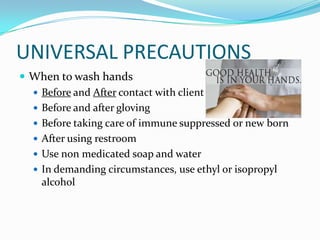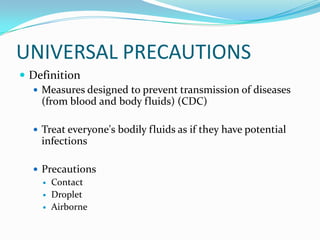Universal Precautions Is Best Described as :
Changing gloves between. Universal precautions a set of behaviors designed by the CDC to minimize the spread of infectious disease the purpose is to disruptprevent the invasion of bacteria or viruses through the use of appropriate barriers.
An infection control practice where all human blood or OPIM are treated as if they were infectious for HIV HBV HCV and other bloodborne pathogens.

. According to the concept of universal precautions all human blood and certain human body fluids are treated as if known to be infectious for HIV hepatitis B and other blood-borne pathogens 29 CFR 19101030 b definitions. Universal precautions are intended to prevent parenteral mucous membrane and nonintact skin exposures of health-care workers to bloodborne pathogens. There are two main reasons as to why these precautions were implemented.
Universal precautions involve the use of protective barriers such as gloves gowns aprons masks or protective eyewear which can reduce the risk of exposure of the health care workers skin or mucous membranes to potentially infective materials. These entail avoiding contact with an individuals blood or bodily fluids under any circumstance. Absolute risk is low.
H tt ps do io rg 10 3 5 5 0 2 j c s w b 19 4. The AHRQ Health Literacy Universal Precautions Toolkit 2nd edition can help primary care practices reduce the complexity of health care increase patient understanding of health information and enhance support for patients of all health literacy levels. A methodo logy for trauma-informed justice.
Standard Precautions Previously Known as Universal Precautions There is a potential for all blood and body fluids to transmit viruses Therefore. To protect patients and to protect medical staff members themselves. Journal of Community S afety and Well-Being 6 3 15 615 9.
Ammonia is a compound of nitrogen and hydrogen with the formula NH 3A stable binary hydride and the simplest. Washing hands and other skin surfaces that are contaminated with blood or body fluids immediately after a procedure or. Guideline Library plus icon.
Use standard precautions in providing for all. Personal protective equipment PPE refers to wearable equipment that is designed to. Hand hygiene Isolation precautions.
When used in the health care setting these precautions are sometimes referred to as routine precautions and standard precautions. Uses pressure and steam to sterilize objects and instruments. All patients must be treated as if they are infectious.
Question 2 What would a researcher be certain to note while analyzing a microbial sample. Multidrug-resistant organisms MDRO Catheter-associated urinary tract infections CAUTI Intravascular catheter-related infection BSI Organ transplantation. Wearing nitrile or latex gloves Wearing protective eyewear Wearing a.
Universal precautions means any and all samples whether known or unknown are to be treated as potentially hazardous or pathogenic materials. The infection control techniques were essentially good hygiene habits such as hand washing and the use of gloves and other barriers the correct handling of hypodermic needles. Is a really tasty refreshing beverage.
Three Universal Precautions that fall under the category of Body Substance Isolation are. 2 UP is an approach to infection control in which all human blood and certain human body. Using disposable gloves and other protective barriers while examining all patients and while handling needles scalpels.
Universal precauti ons refer to the practice in medicine where healthcare agents are expected to protect themselves with materials like gloves and face shields to prevent contamination by pathogens. Which of the following statements best defines universal precautions. The statement that best describes the term universal precautions is.
Universal precautions should be applied in all workplaces when workers come in contact with blood or other body fluids such as semen vaginal discharge synovial fluid cerebrospinal fluid pleural. Hand hygiene is the most important measure to prevent the spread of infections among patients and DHCP. Universal precautions UP originally recommended by the CDC in the 1980s was introduced as an approach to infection control to protect workers from HIV HBV and other bloodborne pathogens in human blood and certain other body fluids regardless of a patients infection status.
Standard Precautions for All Patient Care. Universal precautions is an approach to infection control. Universal precautions are a set of protective measures one can take to prevent transmission of communicable diseases.
Is a strong chemical such as bleach that destroys pathogens on objects not on skin. Universal precautions were particularly made to protect against blood. Universal precautions refers to the practice in medicine of avoiding contact with patients bodily fluids by means of the wearing of nonporous articles such as medical gloves goggles and face shields.
Its a method of control to protect employees from exposure to all human blood and other. Universal Precautions Are Best Described as Which of the Following By Ra_Catalina594 22 Apr 2022 Post a Comment The first fighting took place several months after the landing of the First Fleet in January 1788 and the last clashes. Standard Precautions Hand Hygiene.
Is an agent that is applied directly to the skin with the purpose of killing pathogens. OSHA the Occupational Safety and Health Administration first mandated the use of universal precautions in the early 90s. Universal precautions means any and all samples whether known or unknown are to be treated as potentially hazardous or pathogenic materials.

Printable Universal Precautions Sign Infection Control Nursing Dental Infection Community Health Nursing


No comments for "Universal Precautions Is Best Described as :"
Post a Comment